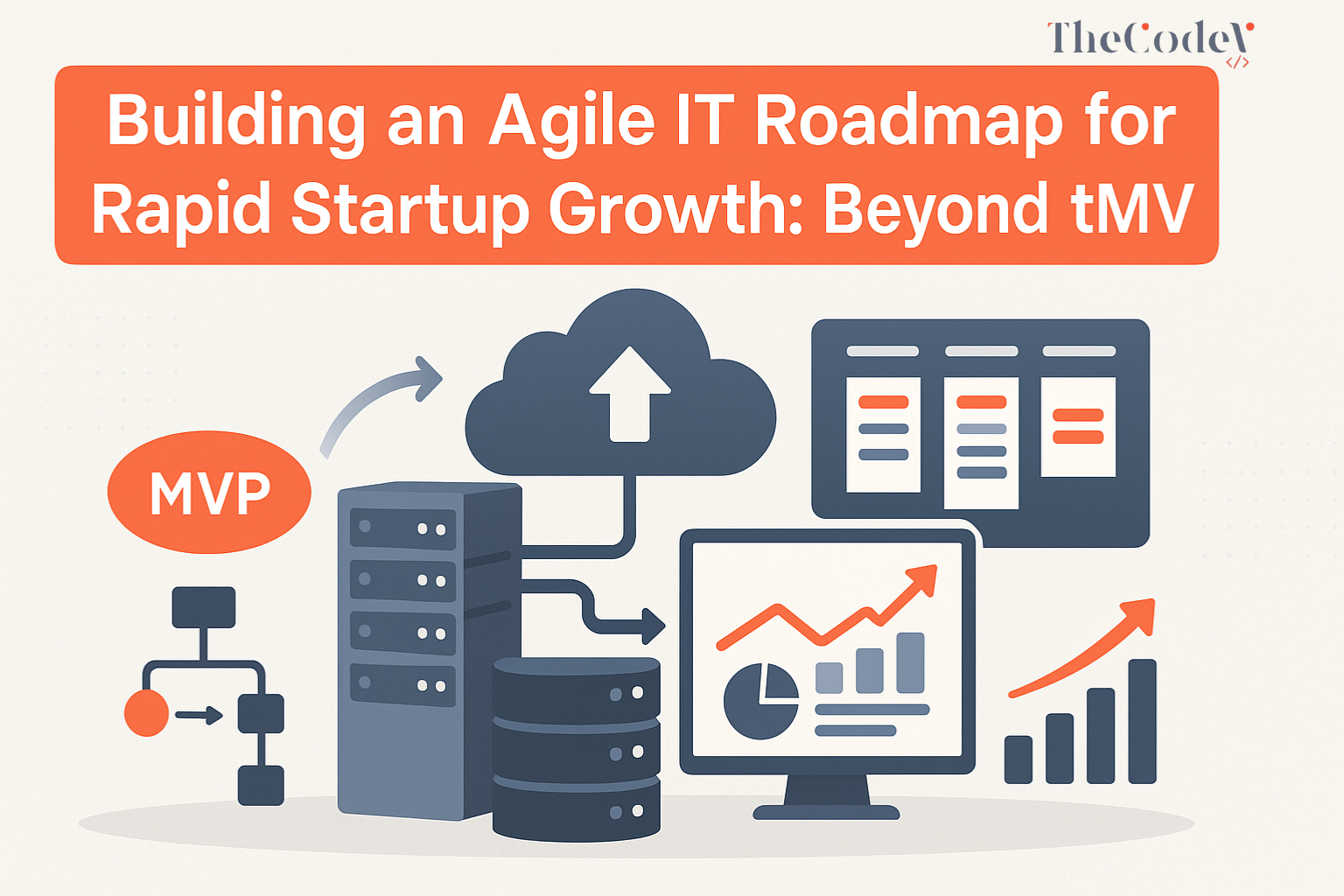Building an Agile IT Roadmap for Rapid Startup Growth: Beyond the MVP
Why the MVP Alone Won’t Take You the Distance
In today’s volatile startup landscape, launching a minimum viable product (MVP) is no longer the finish line—it’s the starting block. While the MVP is a valuable tool for testing assumptions and gathering early feedback, relying on it as the cornerstone of your long-term strategy is a recipe for stalled growth and technical debt. Startups that scale successfully don’t just ship fast—they evolve deliberately, backed by a future-proof, agile IT roadmap.
The reality? Your MVP validates an idea. But it’s your agile IT roadmap that turns that idea into a sustainable business.
Too often, early-stage founders neglect the importance of startup IT planning, focusing solely on lean execution and time-to-market. But what happens after user acquisition begins to spike? What about when investor expectations shift from “launch” to “scale”? Without a clear plan to scale your technology stack, maintain system performance, and iterate quickly, your startup can become a victim of its own momentum.
At TheCodeV, we’ve helped dozens of global startups go beyond the MVP—engineering robust, adaptive infrastructures that accelerate user growth, ensure product stability, and align with evolving business goals. This process hinges on a well-defined, agile digital roadmap that grows as you grow.
A forward-thinking roadmap isn’t just about what to build next. It’s about:
-
Mapping product goals to technical milestones
-
Ensuring your cloud infrastructure can handle traffic surges
-
Planning for integrations, compliance, and modular upgrades
-
Incorporating technology scaling without sacrificing agility
If your IT plan ends at your MVP, you’re already falling behind.
In the rest of this blog, we’ll break down exactly how to build a scalable, agile IT roadmap tailored for startup success. We’ll explore how to move from MVP to market fit, embed agile principles into your infrastructure, align business goals with technical development, and optimise performance post-launch. Whether you’re a founder, CTO, or product lead, this guide will help you future-proof your startup with strategic foresight.
Looking to upgrade your digital foundation today? Explore our full suite of digital services to discover how TheCodeV can power your next growth phase.
Moving Beyond the MVP
The MVP proves viability—but to scale, you must evolve. Startups that remain anchored to MVP-level codebases often encounter serious performance, security, and scalability bottlenecks. To compete in fast-moving markets, a robust agile IT roadmap must go beyond lean prototyping and anticipate the infrastructure needs of tomorrow.
After product-market fit, your next milestone should be investing in scalable architecture—one that supports high availability, modular growth, and rapid deployment cycles. This shift isn’t a luxury; it’s essential for growth-focused startups.
Establishing a Scalable Tech Stack Early
Choosing the right tech stack early helps avoid painful rewrites later. Instead of a “move fast and patch later” approach, startups should invest in frameworks and services designed for cloud scalability and long-term stability.
Startups should prioritise:
-
Modular frontend frameworks (React, Vue)
-
Backend frameworks supporting microservices (Node.js, Django, NestJS)
-
API-first development using RESTful or GraphQL standards
This foundation enables seamless integration with third-party tools, marketplaces, and analytics platforms—key for agile experimentation and future pivoting.
🔗 Learn more about our custom digital services and stack advisory at TheCodeV.
Cloud Scalability for Startups
Infrastructure must grow with your user base. MVPs typically run on shared or limited hosting, but once usage surges, elastic compute and global distribution become critical. Cloud scalability for startups means planning for load balancing, containerisation (Docker, Kubernetes), and environment-based deployment (staging, production, CI/CD pipelines).
Platforms like AWS, Google Cloud, and Microsoft Azure offer solutions tailored for early-stage startups with room to scale. Selecting the right one depends on expected workload, technical skills, and regulatory needs. According to TechCrunch, cloud-native startups outperform legacy-driven competitors in time-to-market and operating efficiency.
➡️ Compare leading cloud providers in our in-depth cloud infrastructure comparison guide.
Designing for API-First Development
Your product is not just a UI; it’s a platform. By building with API-first development in mind, startups enable future integrations—mobile apps, partner dashboards, and third-party services. APIs should be secure, well-documented, and version-controlled from day one.
A scalable system assumes its future will involve:
-
Multiple frontend interfaces (web, mobile, wearables)
-
Data exchange with clients and external partners
-
Automation, reporting, and analytics extensions
Well-designed APIs also allow teams to work in parallel—accelerating time-to-market through microservice autonomy and reducing dependency bottlenecks.
The journey beyond MVP isn’t just about writing better code—it’s about creating a technical architecture that matches your ambition. In the next section, we’ll explore how startups can embed agile principles into their IT roadmaps to handle change, uncertainty, and opportunity with speed and confidence.
Where Product Strategy Meets Tech Execution
For a startup to truly scale, the agile IT roadmap must do more than just guide development—it must mirror the business strategy. Too often, technical roadmaps operate in isolation, disconnected from key performance indicators (KPIs) and commercial objectives. This misalignment stifles growth, delays decision-making, and wastes resources.
A well-structured IT roadmap for business growth begins with understanding your product-market fit. It should reflect the evolution of your value proposition, user needs, and monetisation strategy. As McKinsey notes, companies that tightly align product vision and technical execution experience 30% higher ROI on digital investments (McKinsey Digital).
At TheCodeV, we believe in an outcome-driven roadmap—one that connects each sprint to a business milestone. Whether it’s user acquisition, retention, or revenue generation, your agile IT roadmap should be a direct enabler of those metrics.
Balancing Speed, Stability, and Vision
Startups often face a trilemma: move fast, build stable systems, or pursue a long-term vision. While most default to speed, the real winners are those who build agility into their processes without sacrificing architecture or foresight.
This balance is achieved through:
-
Cross-functional collaboration between product, engineering, and business teams
-
Roadmap iteration driven by customer feedback and live metrics
-
Transparent KPI setting that informs technical prioritisation
For example, if your KPI is reducing churn, your IT roadmap might prioritise faster load times, improved onboarding, or data integrations for personalisation. Each technical milestone should ladder up to a measurable business outcome—this is the essence of a strong startup alignment strategy.
Regular feedback loops and stakeholder reviews ensure alignment. Agile ceremonies like sprint planning and backlog grooming should include not just developers, but also product managers and business leads. This enhances tech-business collaboration, encourages shared ownership, and eliminates siloed thinking.
🔗 See how we blend strategy and engineering in our approach to digital transformation.
By synchronising the agile IT roadmap with broader business KPIs, startups can navigate uncertainty with strategic clarity. In the following section, we’ll examine how scaling your infrastructure, security, and performance monitoring prepares your roadmap—and your product—for long-term sustainability.
Scaling Starts with Smart Infrastructure
The transition from a lean MVP to a fully scalable product hinges on one critical element—your infrastructure. A startup’s ability to grow rapidly and reliably depends on having a robust, modular, and cloud-native foundation. This is where an agile IT roadmap becomes indispensable.
Scalability starts with decoupling your system using microservices architecture. Unlike monolithic setups, microservices allow different components of your application to scale independently. This flexibility means your user authentication system, for instance, can scale separately from your payment gateway—ensuring efficiency and cost control.
Incorporating DevOps for scaling is equally vital. By automating testing, deployment, and environment configuration, you eliminate delays and reduce the risk of human error. DevOps also enables faster iterations and a smoother CI/CD (Continuous Integration and Continuous Deployment) pipeline—core tenets of any agile system.
At TheCodeV, we help startups deploy cloud-native architectures designed for elasticity, fault tolerance, and geographic distribution. Whether you’re leveraging AWS’s autoscaling groups or Google Cloud’s Kubernetes Engine, choosing the right startup cloud infrastructure tools will determine your uptime and performance under pressure.
📍 Learn more about our intelligent DevOps integrations and automation at
Artificial Intelligence in DevOps
According to AWS Architecture Center, businesses that adopt well-architected frameworks reduce infrastructure costs by up to 40% while improving system availability and agility.
Security and Performance at Scale
As your user base grows, so do the stakes. Performance and security can no longer be afterthoughts—they must be built into your agile IT roadmap from the outset.
For performance, implement automated monitoring and observability tools like Prometheus, Grafana, or Datadog to track server health, page speed, and user flows in real-time. High-performance UX isn’t just about speed—it impacts conversions. The Baymard Institute reports that a 1-second delay in load time can reduce conversions by 7%.
Key practices include:
-
Setting up real-time alerts for latency, downtime, and anomalies
-
Using edge caching and CDNs to reduce load times globally
-
Implementing autoscaling and load balancing for peak traffic resilience
Security must scale too. Enforce zero trust architecture, ensure secure API gateways, and follow least-privilege access controls. As your cloud footprint expands, monitor for compliance risks, audit logs, and vulnerabilities.
Need tailored guidance? 📩 Reach out to our engineers at
TheCodeV Contact Page to design a security-first infrastructure that scales confidently.
Building smart, secure, and performance-driven infrastructure is non-negotiable for high-growth startups. In the next section, we’ll explore how your agile IT roadmap continues to evolve post-launch through data, experimentation, and continuous feedback.


